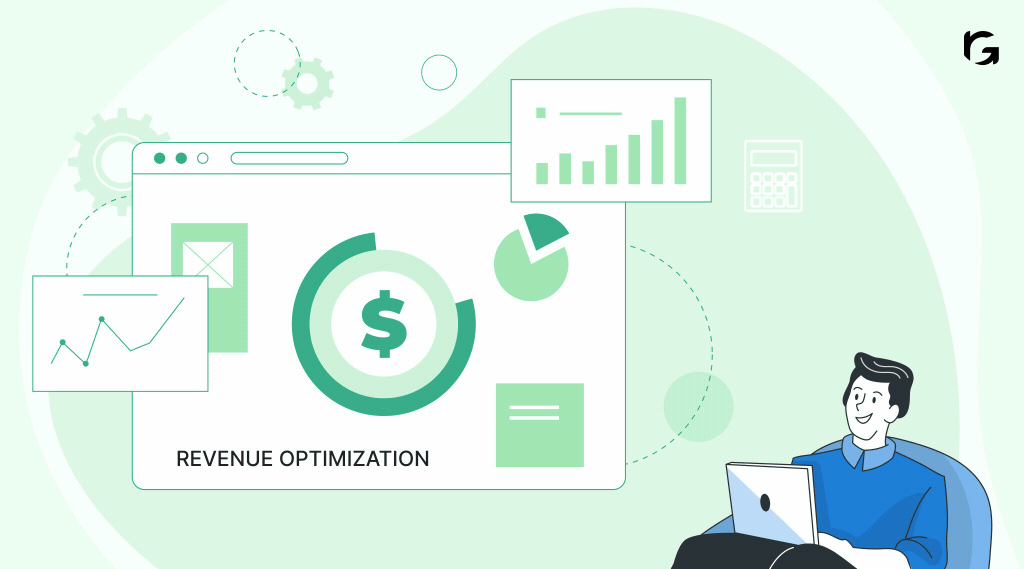Introduction
Your B2B SaaS company consistently hitting its revenue targets and growing steadily, sounds like a dream, right? That’s the power of revenue optimization strategies. It’s about smartly boosting earnings through pricing adjustments, refined sales tactics, and better customer engagement.
Revenue optimization is crucial for B2B SaaS companies to achieve profitability and sustainable growth. By focusing on this, businesses can ensure their pricing models, customer retention strategies, and sales processes work together to improve the bottom line.
You might be thinking, “Where do I even start?” Don’t worry, we got you. Many SaaS companies face the challenge of increasing their revenue without drastically increasing their costs. The good news is there are proven strategies that can help you achieve this balance. In this blog, we’ll explore some of the top revenue optimization strategies specifically designed for B2B SaaS businesses.
What is revenue optimization?
Before we get into the strategies, let’s take a moment to understand what revenue optimization really means. Revenue optimization is about finding ways to increase your income without raising your costs too much. For B2B SaaS companies, this could mean tweaking your pricing, keeping your customers happy so they stay longer, or reaching new markets.
Why does revenue optimization matter? Well, it ensures that you’re making the most out of every customer and every sale. It’s about smart choices that help your business grow and stay profitable. But it’s not always easy. Many B2B companies struggle with setting the right prices, keeping customers from leaving, and controlling the costs of attracting new customers. These challenges can slow down your growth if not handled well.
Understanding these issues is the first step to solving them. Now that we’ve covered the basics, let’s get into some factors affecting your revenue.
Factors affecting revenue optimization
Optimizing revenue in your B2B SaaS business involves several key strategies. Let’s explore how you can fine-tune these elements to maximize earnings and drive growth:
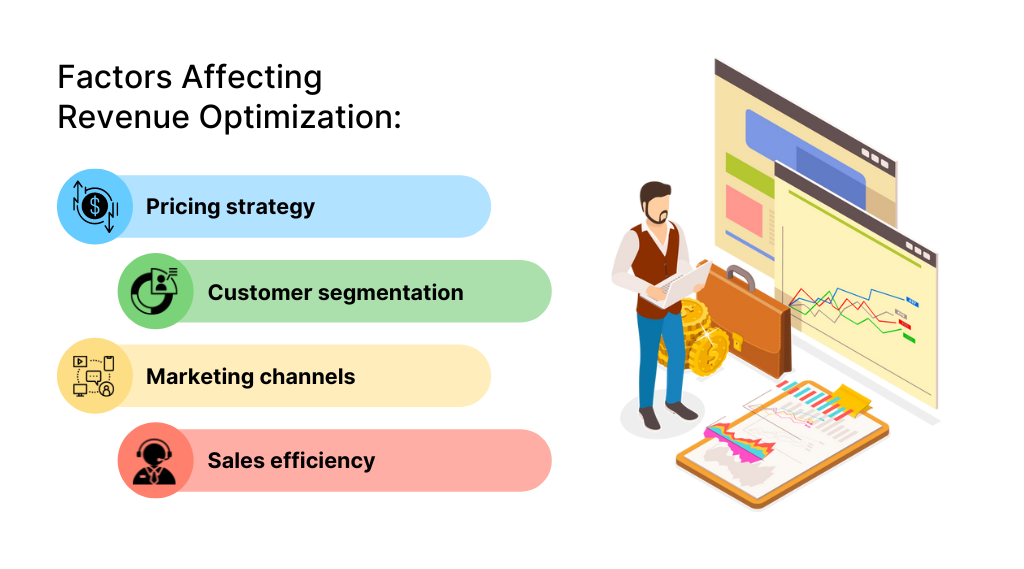
- Pricing strategy
- Customer segmentation
- Marketing channels
- Sales efficiency
Pricing strategy
First up, let’s talk pricing. Effective pricing strategies are crucial for optimizing revenue. One approach is dynamic pricing, which adjusts prices based on demand and market conditions. Think of how Uber prices surge during peak hours.
Similarly, usage-based pricing lets customers pay according to usage, making them feel they’re getting value for their money. But here’s a tip; avoid changing prices too often. Customers appreciate the consistency and trust stable pricing. So, keep changes minimal and strategic to prevent customer churn.
Customer segmentation
Understanding your customers is key. You can tailor your marketing and sales efforts more effectively by segmenting them based on demographics, usage patterns, and success data.
For instance, if you provide project management software, you might segment customers into small businesses, mid-sized companies, and large enterprises. Each segment has unique needs and budgets. Crafting specific marketing messages and offers for each group can boost engagement and conversions, ultimately driving more revenue.
Marketing channels
Choosing the right marketing channels can significantly impact your revenue. Different channels work better for various audiences.
For example, LinkedIn is often more effective for reaching B2B clients than Facebook. It’s essential to measure the effectiveness of each channel accurately. If you run an email campaign that generates high-quality leads, track its impact on revenue. This way, you can allocate your marketing budget more effectively and focus on the channels that bring the best returns.
Sales efficiency
Improving your sales team’s efficiency can directly boost your revenue. This involves better lead management, interactive product demos, and advanced sales tools.
For example, a CRM system can help track customer interactions and automate follow-ups, ensuring no leads are lost. Interactive product demos allow potential customers to experience your software firsthand, increasing their likelihood of purchase.
This will help you increase your earnings and build a stronger, more sustainable business.
6 Strategies for revenue optimization
Many businesses face problems like flat sales, losing customers, and pricing that just doesn’t work. Tackling these issues is key to boosting your revenue and growing your business over the long term.
Here are six proven techniques to help you overcome these challenges and optimize your revenue:
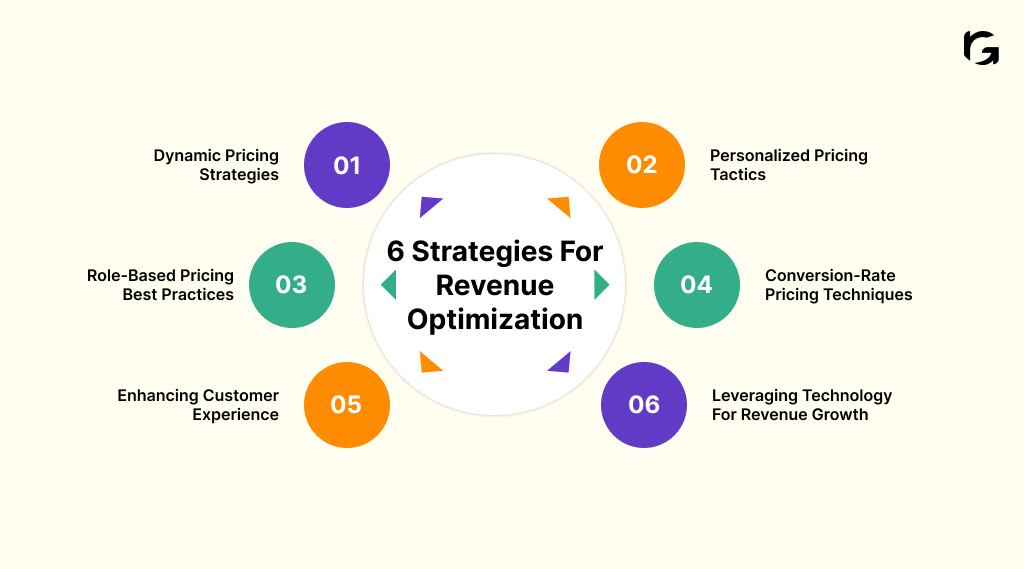
- Dynamic pricing strategies
- Personalized pricing tactics
- Role-based pricing best practices
- Conversion-rate pricing techniques
- Enhancing customer experience
- Leveraging technology for revenue growth
1. Dynamic pricing strategies
Let’s talk about dynamic pricing and how it can boost your revenue. Here’s an easy guide to help you begin.
Data collection
First, you need to gather data. Look at market trends, competitors’ charges, customers’ behavior, and historical sales data. This information is the backbone of your dynamic pricing strategy.
Algorithm development
Next, it’s time to develop pricing algorithms. You can predict the best pricing points based on your collected data using machine learning models. This helps you stay competitive and maximize your revenue.
Scenario planning
Now, create different pricing scenarios. Simulate how each scenario would impact your sales and revenue. This helps you see which strategy might work best in various situations.
Implementation
Once you’ve chosen your strategy, integrate the dynamic pricing algorithm into your pricing system. Start with a pilot phase to test it out. This enables you to make modifications before a complete rollout.
Monitoring and adjustment
Finally, monitor how your dynamic pricing model performs. Continuously monitor and tweak the algorithms based on real-time data to ensure they stay effective.
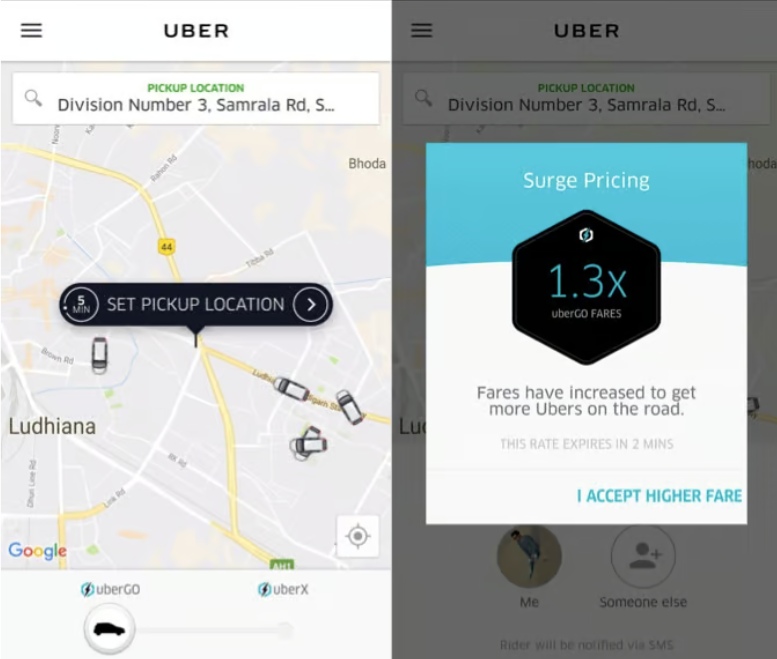
Take Uber, for example. They use a dynamic pricing model known as “surge pricing.” They raise prices during peak hours or in high-demand areas to encourage more drivers to hit the road. This ensures enough drivers are available, reducing wait times and boosting revenue. It’s a win-win.
It’s a powerful way to increase your earnings and stay competitive.
2. Personalized pricing tactics
Customer segmentation is a game-changer in revenue optimization. Here’s how to effectively segment your customer base.
Behavioral segmentation
Start by observing your customers’ behavior. Analyze their purchasing patterns, how often they use your product, and what features they prefer. This will help you understand what drives their buying decisions.
Demographic segmentation
Next, consider demographic factors like age, gender, income level, and location. This information can help tailor your marketing efforts to specific groups, making your campaigns more effective.
Psychographic segmentation
Dive into your customers’ values, attitudes, and lifestyles. Understanding these aspects can help you connect with them deeper and craft more personalized messages.
Purchase history analysis
Review your customers’ purchases to identify trends and preferences. This can give you insights into what they might want next and how to keep them engaged.

Spotify is an excellent example of effective customer segmentation. It uses personalized pricing for its subscription plans, offering discounts for students and family plans. By segmenting users based on demographics and behavior, Spotify has attracted and retained a diverse user base. This strategy has boosted subscriptions and enhanced customer loyalty, proving the power of thoughtful segmentation and personalization.
3. Role-based pricing best practices
Role-based pricing is a smart way to tailor your pricing strategy to different user needs within the organization. Here’s how to do it effectively:
Admin vs. end-user pricing
Offer advanced features and administrative control to admins at a higher price point while providing basic functionalities to end-users. This ensures that each user pays for the level of service they need.
Tiered access
Create different pricing tiers for varying levels of access and functionality within the same organization. This way, you can cater to both power and casual users, maximizing value and satisfaction for everyone.
Customer feedback
Listen to your customers and use their feedback to refine your role-based pricing models. This will help you stay aligned with their needs and expectations.
Industry research
Understand the specific needs of different industry verticals. Customize your pricing models accordingly to serve those unique requirements better.

Salesforce is a great example of role-based pricing done right. They provide different editions of their CRM tailored to various user roles, from small businesses to large enterprises. This strategy allows organizations to choose the right features for different user types, ensuring scalability and meeting diverse customer needs.
4. Conversion-rate pricing techniques
Optimizing pricing for better conversion rates can significantly impact your revenue. Here’s how you can do it effectively.
Sales funnel analysis
Start by analyzing your sales funnel. Identify which pricing strategies work best at each stage. For example, an attractive entry-level price might bring more prospects into the funnel, while premium pricing can be more effective at the decision stage for committed buyers.
A/B testing
Experiment with different pricing points to see which ones yield the highest conversion rates. For instance, test a monthly subscription price versus an annual one to determine which attracts more customers.
Iterative adjustments
Continuously adjust your pricing based on customer behavior and conversion data. This helps you stay responsive to market changes and customer preferences, ensuring your pricing remains competitive and appealing.

Dropbox provides a great example of conversion-rate pricing. They start by offering a free tier to attract users. Once users are engaged, Dropbox uses targeted pricing and feature upgrades to convert them into paying customers. By iteratively testing different pricing models, they’ve increased conversion rates and improved customer retention significantly.
Focusing on these techniques can help you optimize your pricing strategy, boost conversions, and drive revenue growth in your B2B SaaS business.
5. Enhancing customer experience
Let’s talk about making your customers happier, which is crucial for keeping them around and boosting your revenue. Here are some straightforward ways to improve their experience.
Customer support
First, invest in top-notch customer support. Quick response times and knowledgeable staff can make all the difference. Imagine turning a frustrated customer into a loyal one by solving their problem efficiently.
Engagement programs
Next, create loyalty programs, user communities, and regular engagement initiatives. These make your customers feel valued and part of your brand’s family.
Feedback loops
Ensure you have a system for gathering and acting on customer feedback. Listening to your customers and improving based on their input can significantly enhance their experience.
Customer journey mapping
Map out the entire customer journey to find touchpoints that can be enhanced. Understanding each step of the customer’s interaction with your brand helps you improve their overall experience.

HubSpot is a good example of enhancing customer experience. Its focus on customer support and engagement through its HubSpot Academy, which offers educational resources, certification programs, and a vibrant user community, has led to high customer satisfaction and retention rates.
6. Leveraging technology for revenue growth
Using technology to boost your revenue is a game-changer for any B2B SaaS business. Here’s how you can do it.
CRM systems
Think of Customer Relationship Management (CRM) systems as your sales team’s best friend. They help with sales forecasting, customer segmentation, and increasing productivity. For instance, a CRM can show which customers are most likely to buy next, letting your sales team focus their efforts where it matters most.
Marketing automation tools
These tools work like an extra pair of hands. They automate repetitive tasks, making your marketing efforts more efficient. Imagine running a perfectly timed email campaign that nurtures leads into paying customers, all without lifting a finger.
Analytics platforms
Data is gold. Analytics tools enable you to make smarter, data-driven decisions. They show you what’s working and what’s not, so you can tweak your strategies and boost revenue.
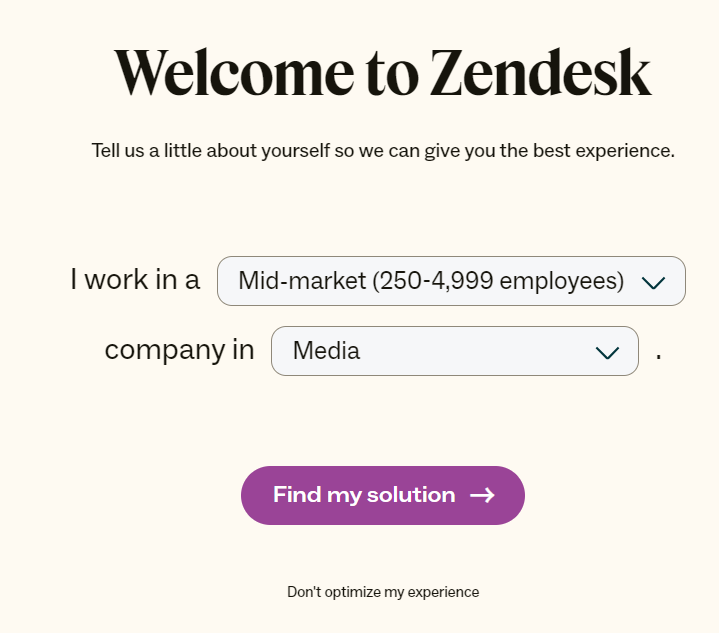
Take Zendesk, for example. They use advanced analytics and CRM integrations to streamline customer support and gain insights into customer behavior. This has helped them improve service quality, increase customer satisfaction, and drive revenue growth.
Future trends in revenue optimization
The future of revenue optimization in SaaS is exciting, and several emerging trends are set to have a significant impact.
- Hyper-personalization: Hyper-personalization will become more prevalent.This means creating unique experiences for each customer based on detailed data. When you can tailor your service to individual needs, customers are happier and more loyal.
- Subscription economy shifts: As more businesses move to subscription models, flexible pricing strategies become crucial. You’ll see more options like pay-as-you-go and tiered subscriptions, making it easier for customers to choose what works best for them.
- Role of AI in pricing: AI will play a bigger role in dynamic pricing, helping businesses adjust prices in real time based on market conditions and customer behavior.
- Integration of blockchain: Blockchain technology will enhance transparency and security in transactions, potentially revolutionizing how revenue is tracked and managed.
Bottom line
Optimizing revenue in your B2B SaaS business isn’t just about one thing—it’s about combining effective pricing strategies, customer segmentation, leveraging technology, and enhancing the customer experience.
Choosing the right strategy can feel overwhelming, but here’s a simple approach: First, align your efforts with your business goals. Then, dive into data analytics to understand your customers’ needs and wants. Try different strategies, such as dynamic pricing, personalized offers, or role-based models, and see what works best. Continuously adjust your approach based on the data you gather.
Ready to boost your revenue? Start by implementing these strategies and stay ahead of the trends.
RevvGrowth helps B2B SaaS businesses grow, generate demand, adopt the right marketing strategies, track performance and critical growth metrics, and stay competitive while maximizing revenue.
Take your B2B SaaS business to new heights. Contact our experts and start your journey towards greater success.
FAQs
1. What is the role of UX and UI in driving conversions?
– Great UX and UI make your website user-friendly and visually appealing, guiding visitors to take action and convert into customers effortlessly.
2. How do you optimize revenue performance?
– We focus on fine-tuning pricing, improving customer retention, and leveraging data analytics to consistently boost revenue performance.
3. How do you optimize revenue generation?
– We enhance revenue generation by identifying new market opportunities, refining sales strategies, and improving customer acquisition methods.
4. What are the profit optimization strategies?
– Our profit optimization strategies include cost reduction, efficient resource allocation, and strategic pricing adjustments to maximize profitability.
5. What are the strategies for building revenue?
– To build revenue, we employ targeted marketing, diversify income streams, and focus on enhancing customer satisfaction and loyalty.

